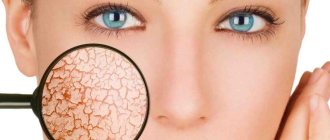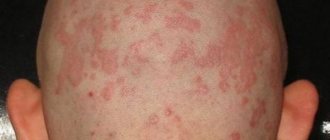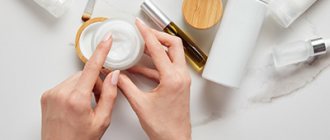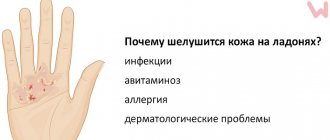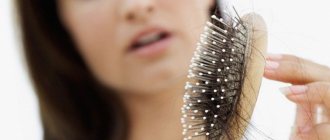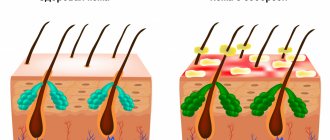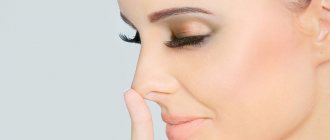Due to disruption of the sebaceous and sweat glands, flaking may form on the skin of the nose. The occurrence of this unpleasant symptom is caused by factors such as poor personal hygiene, poor ecology, and diseases of internal organs. Peeling prevents a person from living fully, as it is accompanied by itching and burning. Skin cells die and are shed faster than usual. A peeling nose becomes red, inflamed and very itchy. There are various methods for solving this problem, including professional and folk remedies.
- Creams
Why does the skin on my nose peel?
There are two types of causes of skin peeling: physiological and pathological. Among the most common are:
- Avitaminosis. A lack of vitamins D, C, A, PP, E, K, B can provoke peeling of the skin.
- Allergy to low-quality cosmetics. It is observed in people with sensitive skin types.
- Respiratory diseases. Due to a runny nose, a person is forced to frequently touch the nose area with a napkin or handkerchief, which can cause the skin to dry out. Also, the components of the drops can cause irritation.
- Environmental influence. Abnormal air temperatures, high or low, affect the condition of the skin.
- Incorrect facial care. Using products that do not match your skin type can cause dryness of the upper layer of the epithelium.
- Hormonal changes. Increased levels of the stress hormone (cortisol) lead to peeling of the facial skin.
- Salon procedures. Techniques such as ultrasonic, mechanical or combined facial cleansing cause peeling of the skin for 5 days.
The skin on the nose can peel off for pathological reasons:
- Fungus (candidiasis, rubromycosis, pityriasis versicolor, microsporia, trichophytosis, seborrheic dermatitis). The latter is caused by the yeast-like fungus Malassezia, the causative agents of the others are Trichophyton, Microsporum, Candida.
- Dermatitis of another etiology (perioral). It occurs due to long-term use of corticosteroids.
- Acne (blackheads). This inflammatory skin condition causes excess sebum production, causing clogged pores and resulting in flaking of cells.
- Systemic lupus erythematosus. The human body begins to fight with its own cells. The disease occurs due to genetic characteristics and hormonal changes.
- Lupus pernio (lupus pernio). Accompanied by staining of the skin of the nose. Its exact causes are unknown, but genetic predisposition may play a role.
- Psoriasis. The disease occurs as a result of an immune response, and peeling occurs due to the accelerated rate of cell division.
- Periarteritis nodosa. It is a form of vasculitis affecting small arteries; the exact causes of its occurrence are unknown.
Peeling of the skin of the nose can occur due to piercings. This indicates an allergy to metals. In this case, it is worth replacing the jewelry.
Depending on symptoms
When diagnosing the condition, the dermatologist pays attention to the accompanying symptoms. Along with peeling, the following may appear:
- red spots, itching, ulcers - demodicosis;
- irritation - seborrheic dermatitis;
- redness - hyperemia of the skin;
- itching, tightness, red spots similar to pimples - fungal infection;
- pain, cracks - eczema;
- rash, tingling, dry skin - allergies.
Depending on location
The area of peeling can tell more about why this skin defect appears. Depending on the local location of the deficiency, the following causes of its occurrence are distinguished:
- around the nose and mouth - vitamin B deficiency;
- on the forehead and around the nose - dermatitis;
- scalp, forehead and nose - inflammation in the lower layer of the epidermis;
- on the chin and nose - diseases of the digestive system;
- under the nose, on the wings of the nose and around the nostrils - previous acute respiratory infections, the use of sprays and drops for a runny nose;
- on the sides - rosacea (a skin condition accompanied by superficial dilatation of blood vessels, swelling, papules, pustules);
- bridge of the nose - allergic reaction.
Skin care in winter: advice from cosmetologists
Advice from a professional is never superfluous, so you should take it into account.
- A very hot shower, especially a long one, can destroy the lipid layer and affect fatty acids. Therefore, all water procedures should be carried out in a gentle thermal regime.
- Before applying foundation to the skin, you should gently exfoliate and apply an emollient cream. In this case, the foundation will lie evenly. Peels should be carried out regularly; they perfectly remove dead scales and improve the condition of the skin. There is one trick that will help cope with the frosty air: add one drop of facial oil to your foundation.
- In winter, you should not forget about your lips. Products for lips should be carefully selected according to the same criteria as for the face. You should not opt for viscous textures; they fill in cracks in the lips, which looks unaesthetic. Also, you should not choose drugs with lanolin.
- After frost, you should not rub your frozen cheeks with your hands. This will make them even redder. Just let your skin get used to the warm room. After a few minutes, you can dust your face with moisturizing powder.
- Wear a hat in winter. This will help avoid drying out your hair.
- Makeup has a beneficial effect on the skin. You can resort to waterproof makeup, since regular makeup can run off in wet snow and strong winds.
- In winter, it is recommended to use masks more often than at other times of the day: every two days.
- In air-conditioned rooms the air is very dry, so it is recommended to purchase a special air humidifier. If this is not possible, then you can place wet towels on the batteries or place containers with water nearby.
- You need to hydrate yourself not only from the outside, but also from inside: in winter, consume about 3 liters of liquid per day.
Treatment methods
If the skin condition does not improve, and the skin peels more, then you should consult a dermatologist. By self-medicating, you can significantly worsen the situation. You should immediately visit a doctor if you have the following symptoms:
- the appearance of eczema;
- occurrence of cracks;
- the appearance of pain;
- increase in the area of peeling.
Therapy for each condition is carried out in accordance with the disease. As a general treatment, your doctor may prescribe:
- creams;
- vitamin complexes;
- drugs;
- folk remedies;
- diet.
You can get rid of peeling skin on the nose at home using folk remedies - masks. But this treatment must be agreed with a dermatologist.
Creams
If the skin begins to peel, it may have happened after using cosmetics. In this case, this indicates an allergic reaction. If this is the case, then you should stop using cosmetics for a while, and then change it to a more suitable one. The following creams are considered hypoallergenic:
- For hands: Mineral Hand Cream, Ahava.
- For eyelids: Pep-Start, Clinique.
- For the face: Toleriane Riche, La-Roche-Posay.
If the skin peels off after a long stay in the sun or in the cold, then before going outside you should use special protective creams:
- From the sun: Hydrance Optimale Creme hydratante UV Legere SPF 20, Avene.
- From wind, cold: Hirudo Derm Sensi Protect Extreme.
If the causes of peeling are caused by mechanical stress (frequent use of paper towels), then a moisturizer (Galderma Cetaphil DERMA CONTROL) will help.
Vitamin complexes
It is necessary to replenish vitamins comprehensively. The most beneficial for facial skin are the following:
- calciferol (D) - reduces the symptoms of psoriasis (flaking and redness);
- ascorbic acid (C) - promotes collagen production;
- retinol (A) - has moisturizing and rejuvenating effects;
- nicotinic acid (PP) - cleanses facial pores, activates vascular blood flow;
- tocopherol (E) - makes the epidermis smooth;
- phylloquinone (K) - stimulates the skin restoration process;
- group B - prevent peeling, eliminate the appearance of dermatitis.
For this purpose, vitamin complexes are used. The list of the most effective includes the following names:
- Vitrum;
- Calcium-D3 Nycomed;
- Calcium-Active;
- Calcide;
- Vitalipid;
- Doppelhertz Active.
Drugs
To get rid of peeling, in addition to creams, healing ointments are applied to the skin. They must be used in accordance with the instructions for each drug.
Names of pharmaceutical ointments that help cope with peeling:
- Hydrocortisone 5%;
- Aquaphor;
- Dexpanthenol;
- Bepanten;
- Panthenol;
- Zinc ointment;
- La Cree;
- Losterol;
- Lipobase.
Folk remedies
You can cope with areas of peeling and soothe inflamed skin at home using masks. Before using them, it is necessary to test for an allergic reaction. It is forbidden to use folk remedies if there is an individual sensitivity to their ingredients.
Recipes for preparing and using masks for peeling skin:
| Mask name | Ingredients | Cooking method | How to use |
| Egg mask |
| Mix the yolk with juice |
|
| Fruit mask |
| Mix the ingredients until it becomes creamy | Apply to face for 15 minutes |
| Colloidal oatmeal mask |
|
|
|
| Sour cream mask |
| Mix the components in equal proportions |
|
| Peppermint mask |
|
|
|
You can remove dead epidermal cells from the skin using a compress. Gauze needs to be moistened in chamomile infusion (1 tablespoon of raw material per glass of boiling water) and placed on the nose for a few minutes.
Diet
You can improve the condition of your skin, eliminate and subsequently prevent peeling by following a diet. There are a number of products, the use of which leads to a decrease in the skin’s resistance to various weather conditions and adverse factors. All this causes accelerated rejection of epidermal cells.
To normalize nutrition you need:
- eat a lot of fruits and vegetables;
- exclude strong tea, spicy and fatty foods, fast food;
- try not to eat sweets and starchy foods;
- give preference to herbal and berry drinks.
Features of treatment in different people
There are no obvious features in the treatment of skin peeling in men, women and children. It is only necessary to select suitable products taking into account gender and age.
Peeling on the nose can occur in men due to a problem such as dandruff, which is initially localized on the eyebrows. White scales sometimes form not in the eyebrow arches themselves, but above the forehead, temples and in the nose area. To treat this condition you can use:
- antifungal agents (creams with ketoconazole);
- antiseborrheic drugs (sulsen paste);
- dermatological creams (A-Derma Dermalibour);
- glucocorticosteroids and corticosteroids (Celeston, Kenalog, Hydrocortisone-Richter).
In women, peeling occurs due to hormonal changes. In such cases, it is necessary to take hormonal drugs selected by a doctor. Peeling skin is a common occurrence during pregnancy. During these periods, the body becomes more susceptible to various types of influences. To get rid of a skin defect, a pregnant woman should make vitamin masks (mix 3 drops of liquid vitamins A and E with 2 tablespoons of oatmeal and a drop of olive oil).
To treat peeling on the nose in women from vitamin deficiency, taking vitamins designed specifically taking into account physiological characteristics is recommended. For example:
- Famvital;
- Imedin;
- ArtLife. Woman's Formula;
- Evalar Laura;
- Lady's formula.
The skin near the nose can also peel in a child. Most often this occurs due to skin sensitivity or vitamin deficiency (in a baby there is a lack of vitamins C, A and E). To eliminate the symptom, drugs can be used whose contraindications do not include children's age. These include:
- Bepanten (from birth);
- calendula ointment (at any age);
- Solcoseryl ointment (from one year);
- Levomekol ointment (from birth).
Preventing flaking on the nose
Maintaining personal hygiene and proper facial skin care will help avoid the reappearance of flaky areas on the nose. Recommendations:
- Drink plenty of liquid (about 2 liters).
- Saturate the body with vitamins (D, C, A, PP, E, K).
- Choose cosmetics without components that dehydrate epidermal cells (lanolin, alcohol).
- Avoid soaps with antibacterial effects.
- Use oil-based cleansers.
- Treat your skin with thermal water spray when in a hot climate.
- Apply protective cream 30 minutes before going out.
- Use toner and moisturizer.
Once a week it is useful to exfoliate skin particles with a scrub. To saturate the skin with microelements and vitamins, apply the mask twice a week. For a more detailed skin care plan, you should consult a cosmetologist or dermatologist.
Further care
Dry and flaky facial skin requires careful care. It must be regular and consistent. This is the only way your face will look beautiful and young.
The face should not be injured by hard towels. Use soft tissues, or even better - paper cosmetic wipes. If the tap water is hard, it cannot be used for washing. For these purposes, they take rain and melt water. Hard water can be softened by adding a little borax to it.
The thin epidermis cannot withstand too high temperatures. Ideally, the water should be lukewarm. After water procedures, it is advisable to apply a moisturizer.
It is forbidden to exfoliate the epidermis with abrasive scrubs. They can injure it and cause inflammation. The ideal option is to apply gommage (it covers the face with a thin film that peels off along with dead cells and dirt).
Cosmetics with fragrances are harmful to delicate and thin skin. It is recommended to use hypoallergenic products that contain a minimum amount of natural perfume components. Cosmetic products must be from the same series and have moisturizing properties.
The indoor air should always be humidified. To do this, ventilate the room and use humidifiers.
Not all plants are good for problem skin. Decoctions and infusions of calendula, arnica, and centella enhance inflammatory processes. Decoctions of linden or chamomile flowers will come in handy. Laminaria and fucus are very useful - they soothe the affected skin and moisturize it.
Linden decoction is good for the face
If a woman or girl wants to have healthy and attractive facial skin, she needs to quit smoking and minimize the consumption of alcoholic beverages. If you have these bad habits, all measures to support and treat flaky skin will be ineffective.
